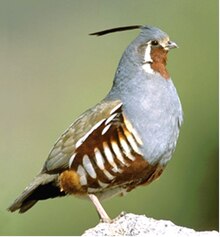
The northern bobwhite, also known as the Virginia quail or bobwhite quail, is a ground-dwelling bird native to Canada, the United States, Mexico, and Cuba, with introduced populations elsewhere in the Caribbean, Europe, and Asia. It is a member of the group of species known as New World quail (Odontophoridae). They were initially placed with the Old World quail in the pheasant family (Phasianidae), but are not particularly closely related. The name "bobwhite" is an onomatopoeic derivation from its characteristic whistling call. Despite its secretive nature, the northern bobwhite is one of the most familiar quails in eastern North America, because it is frequently the only quail in its range. Habitat degradation has contributed to the northern bobwhite population in eastern North America declining by roughly 85% from 1966 to 2014. This population decline is apparently range-wide and continuing.

Quail is a collective name for several genera of mid-sized birds generally placed in the order Galliformes. The collective noun for a group of quail is a flock, covey, or bevy.
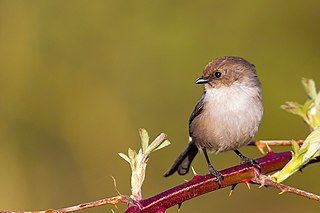
The American bushtit or simply bushtit is a social songbird belonging to the genus Psaltriparus. It is one of the smallest passerines in North America and it is the only species in the family Aegithalidae that is found in United States; the other seven species are found in Eurasia.
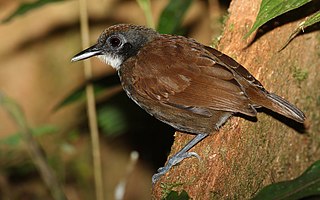
The antbirds are a large passerine bird family, Thamnophilidae, found across subtropical and tropical Central and South America, from Mexico to Argentina. There are more than 230 species, known variously as antshrikes, antwrens, antvireos, fire-eyes, bare-eyes and bushbirds. They are related to the antthrushes and antpittas, the tapaculos, the gnateaters and the ovenbirds. Despite some species' common names, this family is not closely related to the wrens, vireos or shrikes.

The American coot, also known as a mud hen or pouldeau, is a bird of the family Rallidae. Though commonly mistaken for ducks, American coots are only distantly related to ducks, belonging to a separate order. Unlike the webbed feet of ducks, coots have broad, lobed scales on their lower legs and toes that fold back with each step to facilitate walking on dry land. Coots live near water, typically inhabiting wetlands and open water bodies in North America. Groups of coots are called covers or rafts. The oldest known coot lived to be 22 years old.

The long-billed dowitcher is a medium-sized shorebird with a relatively long bill belonging to the sandpiper family, Scolopacidae. In breeding plumage, adults are characterized by a beautiful rufous head and underparts with a darker mottled back and a large white upper rump only seen in flight. They feed in various freshwater habitats with their bill underwater in a "sewing machine" motion and are known to have an exciting mating display where males chase females in flight. The genus, Limnodromus is Ancient Greek from limne, "marsh" and dromos, "racer". The specific scolopaceus is Neo-Latin for "snipe-like", from Latin scolopax, scolopacis, a snipe or woodcock. The English name is from Iroquois and was first recorded in 1841.

The black-chinned hummingbird is a hummingbird occupying a broad range of habitats. Its summer range is in the western United States and southwestern Canada. It is migratory, wintering as far south as Mexico. In sunlight, the gorget of iridescent purple feathers bordering its black chin is noticeable.

The greater sage-grouse, also known as the sagehen, is the largest grouse in North America. Its range is sagebrush country in the western United States and southern Alberta and Saskatchewan, Canada. It was known as simply the sage grouse until the Gunnison sage-grouse was recognized as a separate species in 2000. The Mono Basin population of sage grouse may also be distinct.

The Gunnison grouse, Gunnison sage-grouse or lesser sage-grouse is a species of grouse endemic to the United States. It is similar to the closely related greater sage-grouse in appearance, but about a third smaller in size, with much thicker plumes behind the head; it also has a less elaborate courtship dance. It is restricted in range to southwestern Colorado and extreme southeastern Utah, with the largest population residing in the Gunnison Basin region in Colorado. Despite being native to a country where the avifauna is relatively well known, it was overlooked until the 1990s due to the similarities with the sage grouse, and only described as a new species in 2000—making it the first new avian species to be described from the USA since the 19th century. The description of C. minimus as a separate species is supported by a molecular study of genetic variation, showing that gene flow between the large-bodied and the small-bodied birds is absent.

The grey wagtail is a member of the wagtail family, Motacillidae, measuring around 18–19 cm overall length. The species looks somewhat similar to the yellow wagtail but has the yellow on its underside restricted to the throat and vent. Breeding males have a black throat. The species is widely distributed, with several populations breeding in Eurosiberia and migrating to tropical regions in Asia and Africa. The species is always associated with running water when breeding, although they may use man-made structures near streams for the nest. Outside the breeding season, they may also be seen around lakes, coasts and other watery habitats. Like other wagtails, they frequently wag their tail and fly low with undulations and they have a sharp call that is often given in flight.
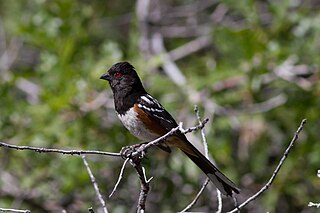
The spotted towhee is a large New World sparrow. The taxonomy of the towhees has been debated in recent decades, and until 1995 this bird and the eastern towhee were considered a single species, the rufous-sided towhee. Another outdated name for the spotted towhee is the Oregon towhee. The call may be harsher and more varied than for the eastern towhee.
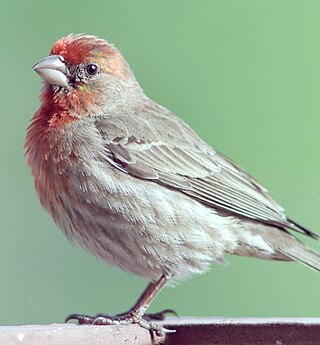
The House finch is a North American bird in the finch family. It is native to Mexico and southwestern United States, but has since been introduced to the eastern part of North America and Hawaii; it is now found year-round in all parts of the United States and most of Mexico, with some residing near the border of Canada. There are estimated to be 40 million house finches across North America, making it the second-most populous finch, just behind the American goldfinch. The house finch and the other two American rosefinches are placed in the genus Haemorhous.

The California quail, also known as the California valley quail or Valley quail, is a small ground-dwelling bird in the New World quail family. These birds have a curving crest or plume, made of six feathers, that droops forward: black in males and brown in females; the flanks are brown with white streaks. Males have a dark brown cap and a black face with a brown back, a grey-blue chest and a light brown belly. Females and immature birds are mainly grey-brown with a light-colored belly. Their closest relative is Gambel's quail, which has a more southerly distribution and a longer crest at 2.5 in (6.4 cm), a brighter head and lacks the scaly appearance of the California quail. The two species separated about 1–2 million years ago, during the Late Pliocene or Early Pleistocene. It was selected as the state bird of California in 1931.

The northern jacana or northern jaçana is a wader which is known as a resident breeder from coastal Mexico to western Panama, and on Cuba, Jamaica and Hispaniola in the Caribbean. It sometimes known to breed in Texas, United States, and has also been recorded on several occasions as a vagrant in Arizona. The jacanas are a group of wetland birds, which are identifiable by their huge feet and claws, which enable them to walk on floating vegetation in the shallow lakes that are their preferred habitat. In Jamaica, this bird is also known as the 'Jesus bird', as it appears to walk on water. Jacana is Linnæus' scientific Latin spelling of the Brazilian Portuguese jaçanã, pronounced, from the Tupi name of the bird. See jacana for pronunciations.

The bristle-thighed curlew is a medium-sized shorebird that breeds in Alaska and winters on tropical Pacific islands.

The shiny cowbird is a passerine bird in the New World family Icteridae. It breeds in most of South America except for dense forests and areas of high altitude such as mountains. Since 1900 the shiny cowbird's range has shifted northward, and it was recorded in the Caribbean islands as well as the United States, where it is found breeding in southern Florida. It is a bird associated with open habitats, including disturbed land from agriculture and deforestation.

Gambel's quail is a small ground-dwelling bird in the New World quail family. It inhabits the desert regions of Arizona, California, Colorado, New Mexico, Nevada, Utah, Texas, and Sonora; also New Mexico-border Chihuahua and the Colorado River region of Baja California. Gambel's quail is named in honor of William Gambel, a 19th-century naturalist and explorer of the Southwestern United States.

Lawrence's goldfinch is a small songbird of erratic distribution that breeds in California and Baja California and winters in the southwestern United States and northern Mexico.

The scaled quail, also commonly called blue quail or cottontop, is a species of the New World quail family. It is a bluish gray bird found in the arid regions of the Southwestern United States to Central Mexico. This species is an early offshoot of the genus Callipepla, diverging in the Pliocene.
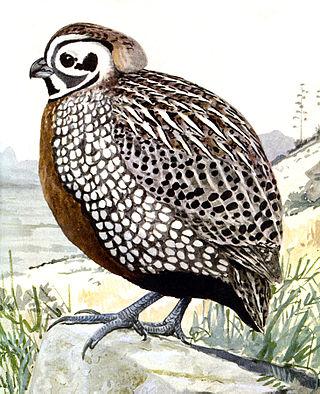
The Montezuma quail is a stubby, secretive New World quail of Mexico and some nearby parts of the United States. It is also known as Mearns's quail, the harlequin quail, and the fool quail.
